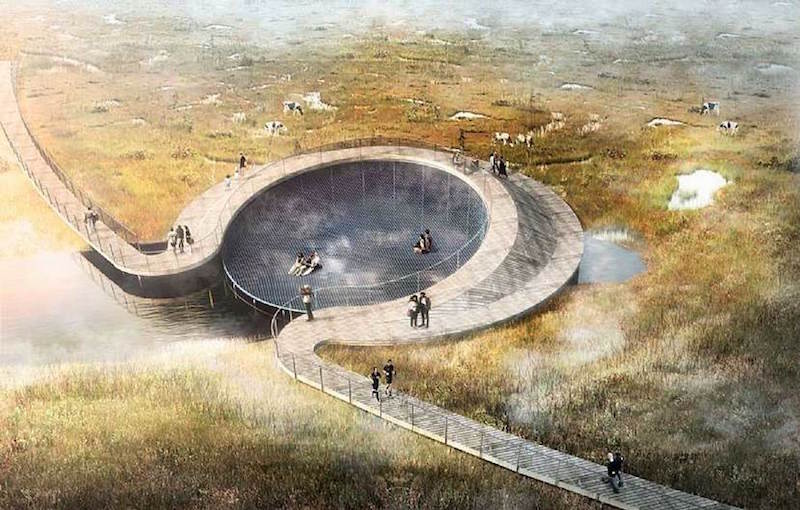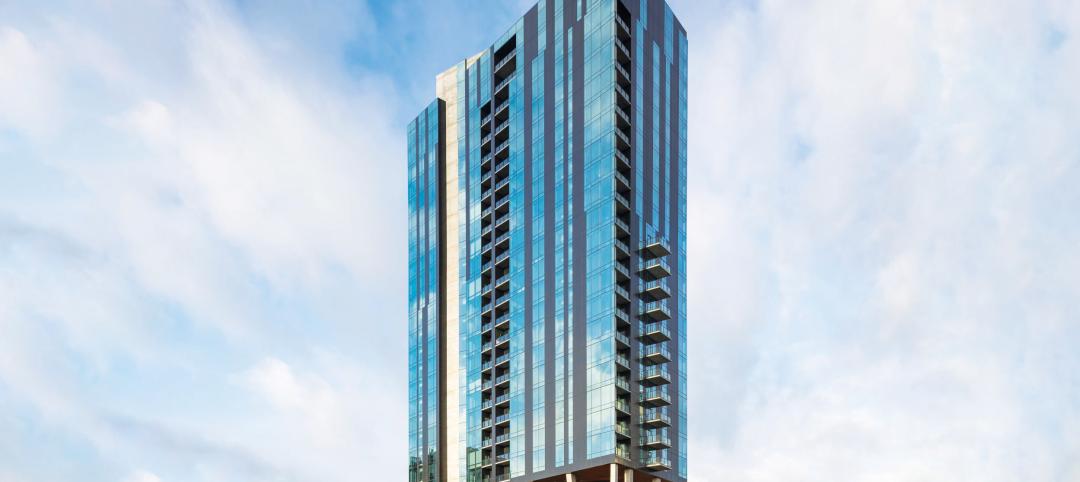C.F. Møller recently won a competition to design a new climate project near Randers, Denmark. Storkeengen, or Stork Meadow, is a new landscape project that creates cloudburst and storm flood protection, strengthens urban nature, and brings the town of Vorup, a suburb of Randers, even closer to the Gudenå River.
The project’s main goal is to resolve the city’s current and future climate challenges by converting Stork Meadow into a public nature park that brings the natural delta along the Gudenå River closer to the center of Randers and its residents. The project’s technical climate protection solutions are based on strengthening the nature value and functionality of the wetland meadow. New cloudburst routes through Vorup lead rainwater from roofs, parking lots, and roads to Stork Meadow.
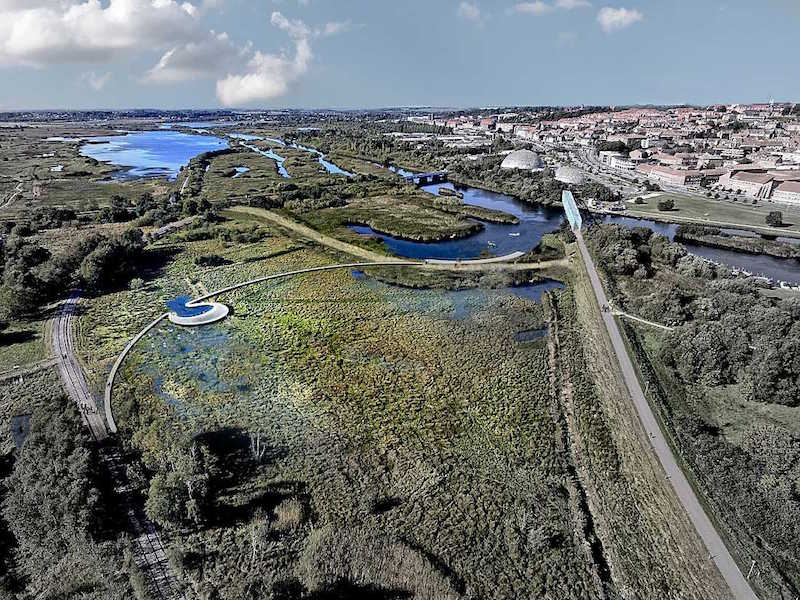 Rendering courtesy of C.F. Møller.
Rendering courtesy of C.F. Møller.
The water is then filtered in purification basins designed as natural wetland meadow areas before being deposited into the Gudenå River. A new dyke between Stork Meadow and the Gudenå will ensure good purification and also protect the low-lying parts of Vorup from flooding. Additionally, the dyke will create new pathways between the center of Randers and the nature areas to the west.
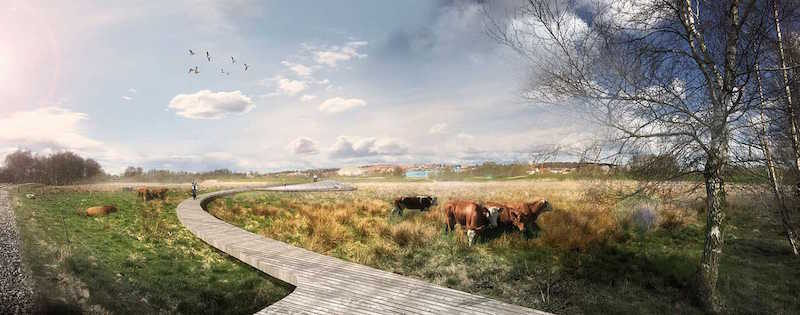 Rendering courtesy of C.F. Møller.
Rendering courtesy of C.F. Møller.
In an effort to enhance the nature experience, activity plateaus will be created to allow people to experience the wet meadow’s habitat up close. These plateaus make it possible to get close to the area’s grazing cattle, enjoy the sunset, or navigate the Gudenå by canoe. Signage with nature information will also be included throughout the project site.
The project will begin construction in fall 2018 and is slated for completion by 2021. C.F. Møller is working with Randers Vandmiljø, Randers Municipality, and Orbicon on the project.
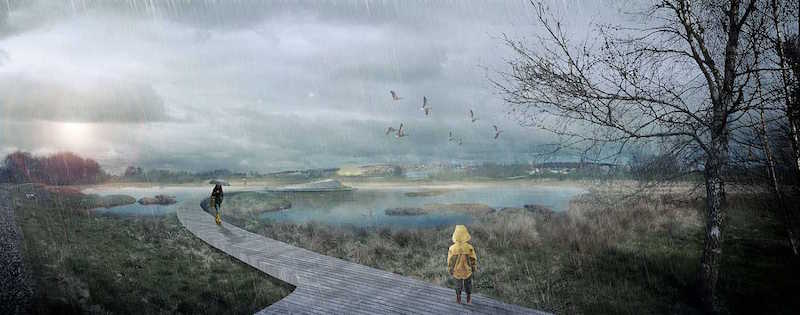 Rendering courtesy of C.F. Møller.
Rendering courtesy of C.F. Møller.
Related Stories
Products and Materials | Jan 18, 2023
6 innovative products for multifamily developments
Here are six innovative products for various multifamily developments, including a condominium-wide smart electrical system, heavy-duty aluminum doors, and prefabricated panels.
Adaptive Reuse | Jan 12, 2023
Invest in existing buildings for your university
According to Nick Sillies of GBBN, students are increasingly asking: "How sustainable is your institution?" Reusing existing buildings may help answer that.
Sponsored | Resiliency | Dec 14, 2022
Flood protection: What building owners need to know to protect their properties
This course from Walter P Moore examines numerous flood protection approaches and building owner needs before delving into the flood protection process. Determining the flood resilience of a property can provide a good understanding of risk associated costs.
Green | Dec 9, 2022
Reaching carbon neutrality in building portfolios ranks high for organizations
Reaching carbon neutrality with their building portfolios ranks high in importance among sustainability goals for organizations responding to a Honeywell/Reuters survey of senior executives at 187 large, multinational corporations. Nearly nine in 10 respondents (87%) say that achieving carbon neutrality in their building portfolio is either extremely (58%) or somewhat (29%) important in relation to their overall ESG goals. Only 4% of respondents called it unimportant.
Green | Dec 9, 2022
Newly formed Net Zero Built Environment Council aims to decarbonize the built world
Global management consulting firm McKinsey recently launched the Net Zero Built Environment Council, a cross-sector coalition of industry stakeholders aiming to decarbonize the built world. The council’s chief goal is to collaboratively create new pathways to cut greenhouse gas emissions from buildings.
Adaptive Reuse | Dec 9, 2022
What's old is new: Why you should consider adaptive reuse
While new construction allows for incredible levels of customization, there’s no denying that new buildings can have adverse impacts on the climate, budgets, schedules and even the cultural and historic fabrics of communities.
75 Top Building Products | Nov 30, 2022
75 top building products for 2022
Each year, the Building Design+Construction editorial team evaluates the vast universe of new and updated products, materials, and systems for the U.S. building design and construction market. The best-of-the-best products make up our annual 75 Top Products report.
Seismic Design | Nov 16, 2022
SPC-4D: 7 reasons California hospital building owners should act now to meet seismic compliance
Seismic compliance with the applicable California building codes is onerous and disruptive for building owners, especially for a building in the heavily regulated sector of healthcare. Owners of older buildings that house acute care services have a big deadline on the horizon—Jan. 1, 2030, the cutoff date to upgrade their buildings to SPC-4D.
Energy-Efficient Design | Nov 14, 2022
How to achieve net zero energy in five steps
Martine Dion and Ethan Seaman share net zero energy best practices with owners and developers.
Resiliency | Nov 8, 2022
Oregon wildfire risk law prompts extensive backlash from property owners
A bipartisan bill aimed at protecting property owners from wildfires that was passed by the Oregon legislature has prompted a strong backlash.


